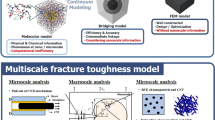Abstract
Nano-filled polymers are becoming more and more important to meet the continuously growing requirements of modern engineering problems. The investigation of these composite materials at the molecular level, however, is either prohibitively expensive or just impossible. Multiscale approaches offer an elegant way to analyze such nanocomposites by significantly reducing computational costs compared to fully molecular simulations. When coupling different time and length scales, however, it is in particular important to ensure that the same material description is applied at each level of resolution. The Capriccio method (Pfaller et al, 2012, 2013), for instance, couples a particle domain modeled with molecular dynamics (MD) with a finite element based continuum description and has been used i.a. to investigate the effects of nano-sized silica additives embedded in atactic polystyrene (PS), cf. Pfaller et al (2016); Liu et al (2017). However, a simple hyperelastic constitutive law is used so far for the continuum description which is not capable to fully match the behavior of the particle domain. To overcome this issue and to enable further optimization of the coupling scheme, the material model used for the continuum should be derived directly from pure MD simulations under thermodynamic conditions identical to those used by the Capriccio method. To this end, we analyze the material response of pure PS under uniaxial deformation using strain-controlled MD simulations (Ries et al, 2019). Analogously, we perform simulations under pure shear deformation to obtain a comprehensive understanding of the material behavior. As a result, the present PS shows viscoelastic characteristics for small strains, whereas viscoplasticity is observed for larger deformations. The insights gained and data generated are used to select a suitable material model whose parameters have to be identified in a subsequent parameter optimization.
Access this chapter
Tax calculation will be finalised at checkout
Purchases are for personal use only
Preview
Unable to display preview. Download preview PDF.
Similar content being viewed by others
References
Ghanbari A, Ndoro TV, Leroy F, Rahimi M, Böhm MC, Müller-Plathe F (2011) Interphase structure in silica–polystyrene nanocomposites: a coarse-grained molecular dynamics study. Macromolecules 45(1):572–584
Giorgio I, Scerrato D (2017) Multi-scale concrete model with rate-dependent internal friction. European Journal of Environmental and Civil Engineering 21(7-8):821–839
Haupt P (1993) On the mathematical modelling of material behavior in continuum mechanics. Acta Mechanica 100(3):129–154
Karimi-Varzaneh HA, Qian HJ, Chen X, Carbone P, Müller-Plathe F (2011) Ibisco: A molecular dynamics simulation package for coarse-grained simulation. Journal of computational chemistry 32(7):1475–1487
Liu S, Pfaller S, Rahimi M, Possart G, Steinmann P, Böhm MC, Müller-Plathe F (2017) Uniaxial deformation of polystyrene–silica nanocomposites studied by hybrid molecular dynamics–finite element simulations. Computational Materials Science 129:1–12
Pfaller S, Possart G, Steinmann P, Rahimi M, Müller-Plathe F, Böhm MC (2012) A comparison of staggered solution schemes for coupled particle–continuum systems modeled with the Arlequin method. Computational Mechanics 49(5):565–579
Pfaller S, Rahimi M, Possart G, Steinmann P, Müller-Plathe F, Böhm M (2013) An arlequin-based method to couple molecular dynamics and finite element simulations of amorphous polymers and nanocomposites. Computer Methods in Applied Mechanics and Engineering 260:109–129
Pfaller S, Possart G, Steinmann P, Rahimi M, Müller-Plathe F, Böhm M (2016) Investigation of interphase effects in silica-polystyrene nanocomposites based on a hybrid molecular-dynamics–finite-element simulation framework. Physical Review E 93(5):052,505
Pfaller S, Kergaßner A, Steinmann P (2019) Optimisation of the capriccio method to couple particle-and continuum-based simulations of polymers. Multiscale Science and Engineering 1(4):318–333
Qian HJ, Carbone P, Chen X, Karimi-Varzaneh HA, Liew CC, Müller-Plathe F (2008) Temperaturetransferable coarse-grained potentials for ethylbenzene, polystyrene, and their mixtures. Macromolecules 41(24):9919–9929
Rahimi M, Iriarte-Carretero I, Ghanbari A, Böhm MC, Müller–Plathe F (2012) Mechanical behavior and interphase structure in a silica-polystyrene nanocomposite under uniaxial deformation. Nanotechnology 23:305,702
Reith D, Pütz M, Müller-Plathe F (2003) Deriving effective mesoscale potentials from atomistic simulations. Journal of computational chemistry 24(13):1624–1636
Ries M, Possart G, Steinmann P, Pfaller S (2019) Extensive cgmd simulations of atactic ps providing pseudo experimental data to calibrate nonlinear inelastic continuum mechanical constitutive laws. Polymers 11(11):1824
Turco E, Dell’Isola F, Misra A (2019) A nonlinear lagrangian particle model for grains assemblies including grain relative rotations. International Journal for Numerical and Analytical Methods in Geomechanics 43(5):1051–1079
ZhaoW, Ries M, Steinmann P, Pfaller S (2020) Aviscoelastic constitutive model for polymers based on molecular dynamics simulation under finite uniaxial deformation. manuscript in preparation
Author information
Authors and Affiliations
Corresponding author
Editor information
Editors and Affiliations
Rights and permissions
Copyright information
© 2020 Springer Nature Switzerland AG
About this chapter
Cite this chapter
Ries, M., Steinmann, P., Pfaller, S. (2020). Characterization of Polystyrene Under Shear Deformation Using Molecular Dynamics. In: Abali, B., Giorgio, I. (eds) Developments and Novel Approaches in Nonlinear Solid Body Mechanics. Advanced Structured Materials, vol 130. Springer, Cham. https://doi.org/10.1007/978-3-030-50460-1_14
Download citation
DOI: https://doi.org/10.1007/978-3-030-50460-1_14
Published:
Publisher Name: Springer, Cham
Print ISBN: 978-3-030-50459-5
Online ISBN: 978-3-030-50460-1
eBook Packages: Physics and AstronomyPhysics and Astronomy (R0)




